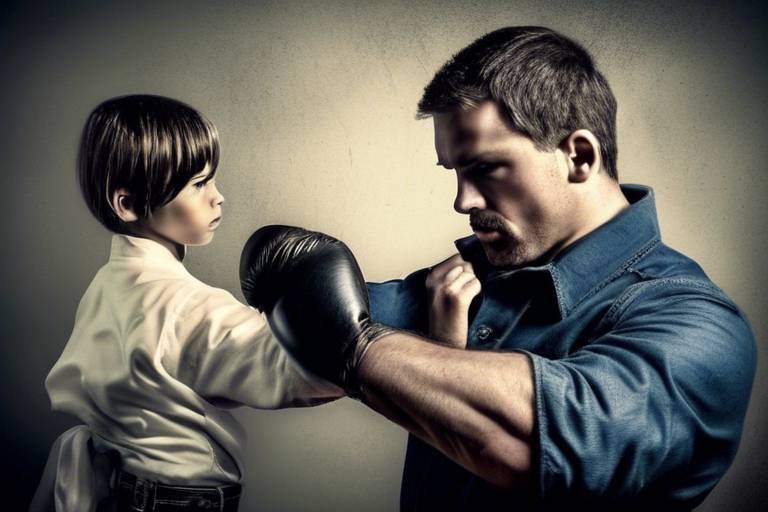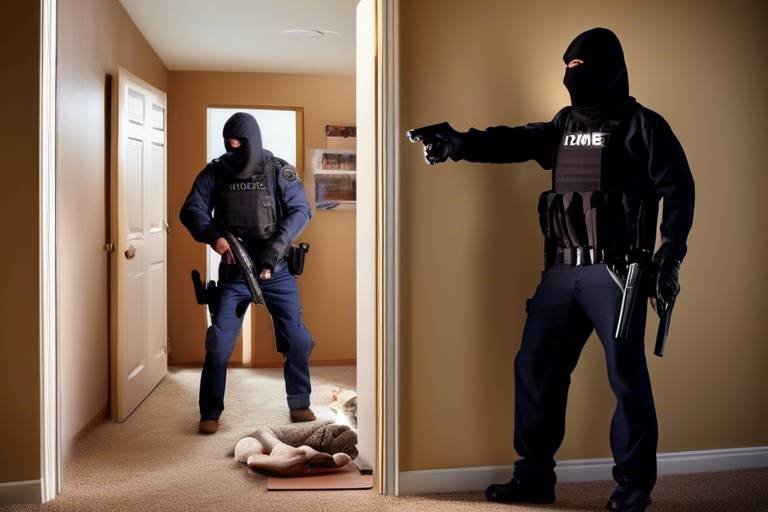Safety and Self Defense - Power of Knowledge
In a world where uncertainties lurk around every corner, the power of knowledge stands as a formidable shield for personal safety and self-defense. Imagine walking down a dimly lit street, the shadows stretching ominously. What if you could arm yourself with the knowledge that not only helps you recognize danger but also empowers you to act decisively? This article dives deep into the significance of understanding personal safety, exploring strategies, techniques, and the crucial element of awareness that enables individuals to protect themselves effectively.
Knowledge is more than just information; it’s a tool that can transform your mindset from vulnerability to empowerment. Just as a knight dons armor before heading into battle, equipping yourself with the right information can be your first line of defense. From understanding your environment to mastering self-defense techniques, every piece of knowledge adds to your arsenal, enhancing your ability to navigate potentially dangerous situations with confidence.
But let’s be real for a moment. Many people think that self-defense is only for those who are physically strong or have a background in martial arts. The truth is, self-defense is accessible to everyone. It’s not just about brute strength; it’s about awareness, strategy, and the will to protect yourself. By cultivating a mindset focused on safety and learning practical techniques, you can become your own best advocate in any situation.
As we journey through this article, we will explore various aspects of personal safety and self-defense, including physical techniques, verbal strategies, and the importance of situational awareness. Each section is designed to empower you, providing actionable insights that can be applied in real-life scenarios. So, are you ready to take charge of your safety? Let’s dive in!
Personal safety encompasses the awareness and practices that help individuals avoid dangerous situations. It’s about being proactive rather than reactive. Think of it like a game of chess; the more you anticipate your opponent's moves, the better your chances of winning. The foundational principles of staying safe in various environments revolve around awareness, preparation, and confidence.
When you step outside your door, consider the following principles:
- Stay Aware: Always be mindful of your surroundings. This means not just looking around but also tuning into the vibe of the area. Are people acting strangely? Is something off?
- Plan Your Routes: Whether you’re walking, driving, or taking public transport, have a mental map of safe routes. Familiarity breeds comfort, and comfort breeds safety.
- Trust Your Gut: If something doesn’t feel right, it probably isn’t. Your instincts are often your best guide.
By integrating these principles into your daily life, you create a strong foundation for personal safety. Remember, safety isn’t just a reaction; it’s a lifestyle.
Now that we have a solid understanding of personal safety, let’s delve into self-defense techniques. Self-defense is not about fighting; it’s about protecting yourself and escaping danger. It’s essential to learn various techniques that can help you in real-life confrontations. Training is key; the more you practice, the more instinctive these moves will become.
Physical self-defense techniques are designed for individuals of all skill levels. You don’t need to be a martial arts expert to defend yourself effectively. Here are a couple of key moves you can learn:
Striking techniques are crucial in self-defense. They can incapacitate an attacker effectively, allowing you to escape. Here are some basic strikes to consider:
- Punches: A well-placed punch to the nose can disorient an attacker.
- Kicks: A swift kick to the groin can provide a vital moment for escape.
Escape techniques focus on getting away from an attacker. Knowing how to break free from holds and flee safely is essential. For instance, if someone grabs your wrist, a simple twist and pull can free you. Always aim to create distance between you and the attacker.
Verbal self-defense is an essential skill for de-escalating confrontations. Sometimes, the best defense is a good offense—verbally speaking, that is. Using confident, assertive language can often diffuse a tense situation before it escalates into physical confrontation. Phrases like "Back off!" or "Leave me alone!" can assert your boundaries and deter potential threats.
Situational awareness is key to avoiding dangerous encounters. It’s about being in tune with your environment and recognizing potential threats before they become real problems. This skill can be developed with practice and mindfulness.
Identifying warning signs in various environments can prevent dangerous situations. Common red flags include:
- Someone following you too closely.
- Unusual behavior from individuals in your vicinity.
- Areas that feel off or unsafe, such as poorly lit streets.
Trusting your instincts can be a powerful tool in personal safety. Your gut feelings are often based on subconscious observations. If something feels wrong, it probably is. Listening to your instincts can be the difference between safety and danger.
Q: What should I do if I feel threatened?
A: Trust your instincts. If you feel threatened, seek a safe location and call for help if necessary.
Q: Can self-defense techniques be learned online?
A: While online resources can provide valuable information, practical training with a qualified instructor is recommended for effective learning.
Q: How can I improve my situational awareness?
A: Practice being observant in your surroundings. Regularly assess your environment and identify potential threats.

Understanding Personal Safety
Personal safety is not just a buzzword; it’s a crucial aspect of our everyday lives. Imagine walking down the street, headphones in, completely unaware of your surroundings. Sounds familiar, right? This is where understanding personal safety comes into play. It’s about being aware and proactive, rather than reactive. By developing a keen sense of awareness, you can significantly reduce the risks of encountering dangerous situations.
At its core, personal safety is about understanding the environment around you. This includes recognizing potential threats and knowing how to respond appropriately. It’s like being a detective in your own life, constantly scanning for clues that could indicate danger. Whether you’re at home, in a public place, or even online, being vigilant can make all the difference. Here are some foundational principles to keep in mind:
- Awareness: Always be conscious of your surroundings. Look out for unusual behavior or situations that seem off.
- Preparation: Have a plan in place for various scenarios. Whether it’s knowing the quickest exit in a building or having emergency contacts saved in your phone, being prepared can empower you.
- Trust Your Gut: If something feels wrong, it probably is. Your instincts are often your best defense.
Understanding personal safety also means recognizing that it’s not just about physical threats. Emotional and psychological safety are equally important. In today’s digital age, online safety has become a significant concern. Cyberbullying, identity theft, and scams are rampant, and being informed about these issues is crucial. Just as you would lock your doors at night, you should also secure your online presence. This includes using strong passwords, being cautious about sharing personal information, and knowing how to identify phishing attempts.
Moreover, personal safety is about fostering a mindset of empowerment. It’s about believing that you have the right to feel safe and secure in any environment. This belief can motivate you to take the necessary steps to protect yourself and those around you. Think of it as a shield; the more knowledge you acquire, the stronger your shield becomes. In essence, personal safety is a combination of awareness, preparation, and empowerment.
In conclusion, understanding personal safety is a lifelong journey. It requires ongoing education and practice. By staying informed and aware, you can navigate your world more confidently and reduce your risk of encountering dangerous situations. Remember, safety starts with you!

Self-Defense Techniques
When it comes to personal safety, the knowledge of can be a game-changer. It's not just about being physically strong; it's about being smart and prepared. Self-defense encompasses a variety of skills that can help you protect yourself in dangerous situations. Whether you're walking home late at night or find yourself in an unexpected confrontation, knowing how to defend yourself can make all the difference. The key to effective self-defense lies in understanding the techniques available and practicing them regularly. After all, just like learning to ride a bike, the more you practice, the better you get!
Self-defense techniques can be broadly categorized into two main types: physical self-defense moves and verbal self-defense strategies. Let's dive into the physical aspect first, because when push comes to shove, you want to be ready to react. Physical self-defense moves can range from simple strikes to complex maneuvers designed to escape holds. It's essential to understand that these techniques are not just for those with martial arts backgrounds; they can be learned and mastered by anyone willing to put in the effort.
Physical self-defense moves are your frontline defense. They include a variety of strategies that can be employed to protect yourself effectively. Here are a few examples of moves that can be useful in a confrontation:
- Punches: A well-placed punch can incapacitate an attacker, especially if aimed at vulnerable areas like the nose or jaw.
- Kicks: Kicking can create distance between you and your attacker, which is often crucial for escaping a dangerous situation.
- Joint Locks: These techniques can immobilize an attacker by targeting their joints, allowing you to break free from holds.
Each of these techniques requires practice to be effective. It’s not enough to just know them; you have to be able to execute them under pressure. Many self-defense classes offer hands-on training that helps you practice these moves in a safe environment. Imagine being in a situation where your heart is racing, and your instincts kick in. The more familiar you are with these techniques, the more likely you are to respond effectively.
Striking techniques are fundamental in self-defense. They involve using your body to deliver impactful blows to an attacker. Think of your body as a weapon; when trained properly, it can be incredibly effective. Some common striking techniques include:
- Jabs and Crosses: These are basic punches that can create openings for escape.
- Elbow Strikes: Close-range strikes that can be very effective in tight situations.
- Front Kicks: A powerful way to push an attacker away and create distance.
It's essential to practice these techniques regularly. You can’t expect to be effective in a real situation if you haven’t trained your body to respond instinctively. Many self-defense classes incorporate striking drills that can help you build muscle memory.
Now, let's talk about escape techniques. The ultimate goal in a dangerous situation is to get away safely. Knowing how to break free from an attacker’s hold can be crucial. Techniques such as:
- Wrist Releases: These moves focus on breaking free from grabs or holds.
- Body Positioning: Learning how to position your body can help you leverage your strength against an attacker.
- Using the Environment: Sometimes, the best escape technique is to use your surroundings to your advantage, like a nearby object to shield yourself.
Remember, the best self-defense is often to avoid confrontation altogether. However, if you find yourself in a situation where you must defend yourself, having these escape techniques in your arsenal can provide you with the confidence to act decisively.
Not all self-defense situations require physical confrontation. In many cases, being able to communicate effectively can diffuse a potentially dangerous encounter. Verbal self-defense strategies involve using your words to assert yourself and deter aggression. Techniques like maintaining a strong posture, using a firm voice, and making direct eye contact can send a clear message to an aggressor that you are not an easy target. Sometimes, a confident "Back off!" can be more effective than any physical move.
In conclusion, self-defense is about being prepared, both physically and mentally. By understanding and practicing various techniques, you can empower yourself to handle potentially dangerous situations. Remember, knowledge is power, and that power can help keep you safe.
Q: Do I need to be strong to defend myself?
A: Not at all! Self-defense techniques focus on strategy and technique rather than brute strength.
Q: How often should I practice self-defense?
A: Regular practice is key. Aim for at least once a week to keep your skills sharp.
Q: Can self-defense training help with confidence?
A: Absolutely! Knowing you can defend yourself boosts your confidence in various situations.

Physical Self-Defense Moves
When it comes to self-defense, having a few effective physical moves up your sleeve can make all the difference. Imagine walking down the street, feeling confident and aware, knowing that if a situation arises, you have the tools to protect yourself. are not just about brute strength; they are about technique, precision, and timing. Whether you're a seasoned martial artist or a complete beginner, there are basic techniques anyone can learn and apply in a real-world scenario.
One of the most fundamental moves is the forward strike. This technique involves using your fist to strike an attacker directly in the nose or chin. The power of this move lies in the fact that it targets sensitive areas, potentially incapacitating the assailant. To execute this move effectively, keep your elbow close to your body, and extend your arm in a straight line towards the target. Remember, aim for the face, as this can create a moment of surprise, allowing you to escape.
Next up is the knee strike. This move is particularly useful if an attacker is close to you. By driving your knee upwards into your assailant's groin or midsection, you can create a significant impact. This move is not only effective but also easy to perform. To practice, find a sturdy bag or a pillow and focus on the upward motion, ensuring you use your hips for added power. The goal here is to generate enough force to create an opening for escape.
Now, let’s talk about the elbow strike. This technique is incredibly effective in close-quarters situations. By using your elbow to strike an attacker's face or body, you can deliver a powerful blow. The elbow is a hard part of your body, and when used correctly, it can cause substantial damage. To practice, simulate a close encounter and focus on driving your elbow into a target, like a heavy bag or even a pillow. This will help you get comfortable with the motion and build confidence.
In addition to these striking techniques, it’s essential to learn some escape techniques as well. For instance, if someone grabs your wrist, you can utilize a simple yet effective move: rotate your wrist towards your thumb while simultaneously stepping back. This motion creates leverage and allows you to break free from the grip. Practicing this with a partner can help reinforce your muscle memory, making it easier to recall during a stressful situation.
Lastly, remember that while these moves are effective, the ultimate goal of self-defense is to escape safely. It’s crucial to keep your head clear and remain aware of your surroundings. Training in a safe environment, such as a self-defense class, can help you practice these moves and build the confidence you need. Regular practice will not only enhance your skills but also empower you to feel more secure in your daily life.
Q: Do I need to be physically strong to defend myself effectively?
A: Not at all! Self-defense is more about technique than strength. Many effective moves rely on leverage and precision rather than brute force.
Q: How often should I practice self-defense techniques?
A: Regular practice is key. Aim to practice at least once a week to keep your skills sharp and your confidence high.
Q: What if I can't remember the moves in a real situation?
A: This is completely normal! The more you practice, the more instinctual the moves will become. Additionally, focusing on staying calm can help you recall your training.
Q: Is self-defense training suitable for everyone?
A: Yes! Self-defense training is beneficial for individuals of all ages, genders, and fitness levels. It's about learning to protect yourself and feeling empowered.

Striking Techniques
When it comes to self-defense, are among the most essential skills you can learn. These techniques are not just about throwing punches or kicks; they are about mastering the art of striking with precision and purpose. Imagine a scenario where you find yourself in a threatening situation. Your ability to deliver a decisive strike can make all the difference. Striking is about empowering yourself, giving you the confidence to stand your ground when necessary.
There are various types of strikes that can be effective in self-defense situations, and understanding how to execute them properly is crucial. Let's break down some of the most common striking techniques that anyone can learn:
- Punches: A well-placed punch can incapacitate an attacker. Techniques such as the jab, cross, and hook are fundamental. The jab is quick and can create distance, while the cross is more powerful and can deliver significant impact.
- Kicks: Kicking can be a highly effective way to defend yourself. Front kicks, side kicks, and roundhouse kicks can target vulnerable areas such as the knees or groin, allowing you to escape.
- Elbow Strikes: In close quarters, elbow strikes can be devastating. They are powerful and can be delivered quickly, making them ideal for self-defense situations.
- Knee Strikes: Similar to elbow strikes, knee strikes are effective when an attacker is close. They can target the groin or stomach, providing a chance to escape.
It's important to remember that striking techniques should be practiced regularly. Just like learning to ride a bike, the more you practice, the more comfortable and effective you will become. Consider enrolling in a local self-defense class or martial arts program to hone your skills. Training not only improves your physical abilities but also boosts your confidence and mental preparedness.
Moreover, understanding the mechanics of striking is vital. Proper stance, balance, and body movement can amplify the effectiveness of your strikes. For instance, when throwing a punch, your feet should be shoulder-width apart, and your weight should shift from your back foot to your front foot. This transfer of weight can significantly increase the power behind your strike.
Finally, while striking techniques are powerful, they should be used responsibly. The goal of self-defense is to protect yourself and escape from danger, not to engage in a fight. Always be aware of your surroundings and use your skills only when absolutely necessary. Remember, the best fight is the one you avoid.
The most effective striking techniques include punches, kicks, elbow strikes, and knee strikes. Each technique can be useful in different scenarios, so it's beneficial to learn a variety of them.
No, physical strength can help, but technique and proper execution are far more important. With practice, anyone can learn to strike effectively, regardless of their physical build.
Regular practice is essential. Aim for at least two to three times a week to build muscle memory and improve your skills.
Yes, striking techniques can be very effective in real-life self-defense situations. However, it's crucial to use them responsibly and only when necessary.

Escape Techniques
When it comes to personal safety, knowing how to escape from a threatening situation can be just as crucial as knowing how to defend yourself physically. Escape techniques are designed to help you break free from an attacker and create an opportunity to get to safety. Think of these techniques as your safety net—essential tools that can help you navigate through dangerous waters. Whether you find yourself in a hold or face-to-face with an aggressor, having the right escape strategies can make all the difference.
One of the most effective escape techniques is the breakaway maneuver. This technique involves using your body weight and momentum to free yourself from an attacker’s grip. For example, if someone grabs your wrist, instead of pulling away directly, you can rotate your wrist towards their thumb, which is the weakest part of their grip. This simple yet effective action can help you slip away and regain your freedom.
Another essential technique is the drop and roll method. If an attacker has you in a bear hug or is attempting to lift you, dropping your weight and rolling can help you escape their grasp. By lowering your center of gravity, you make it harder for them to control you. Imagine a sack of potatoes—if you try to lift it straight up, it’s cumbersome, but if you drop it and roll it, it becomes much easier to maneuver.
Additionally, it’s important to practice situational awareness. This means being mindful of your surroundings and potential escape routes. In any given environment, always look for exits, obstacles, and places to hide. For instance, if you’re in a crowded area, consider how you might navigate through the crowd to reach safety. Knowing where to go even before an incident occurs can give you a significant advantage.
In some cases, verbal techniques can also assist in escape. If you find yourself in a conversation that feels off, using assertive communication can deter an attacker. Phrases like, “I need you to step back,” or “This conversation is over,” can signal your intent to disengage. Sometimes, verbal cues can create enough distance for you to make your exit.
Remember, the goal of these escape techniques is not to confront or overpower your attacker but to create an opportunity to escape safely. Always prioritize your safety and well-being over proving a point. The more you practice these techniques, the more instinctual they will become, allowing you to react swiftly and confidently in a crisis.
- What should I do if I can't escape? If escape is not an option, focus on defending yourself using the techniques you've learned to create an opening for escape.
- How can I practice these techniques safely? Consider enrolling in self-defense classes where you can practice with a partner under the guidance of a trained instructor.
- Are these techniques effective against all attackers? While no technique is foolproof, these methods can increase your chances of escaping a variety of situations.

Verbal Self-Defense Strategies
When it comes to personal safety, verbal self-defense is an often overlooked yet incredibly powerful tool. Think of it as your first line of defense; using your words effectively can not only prevent a situation from escalating but can also empower you to maintain control. Just like a skilled negotiator knows how to navigate tense situations, you too can learn to de-escalate potential threats with the right verbal strategies.
So, what does verbal self-defense really entail? At its core, it’s about **effective communication**. This means not only what you say but how you say it. A calm, assertive tone can be your best friend in a confrontation. Imagine you’re in a heated situation; instead of raising your voice or getting defensive, you take a deep breath and speak clearly. This approach can catch an aggressor off guard, making them reconsider their actions. You might say something like, “I don’t want any trouble; let’s just walk away.” This simple statement can diffuse tension significantly.
Another key aspect of verbal self-defense is **setting boundaries**. It’s essential to communicate your limits clearly. For example, if someone invades your personal space or speaks to you inappropriately, assertively stating, “Please step back, I don’t appreciate that,” can signal to them that you are not someone to be trifled with. This not only protects you but also demonstrates confidence. Remember, confidence is often a deterrent to potential aggressors.
In addition to assertiveness, being aware of your surroundings and the context of the situation plays a crucial role in verbal self-defense. If you notice someone acting suspiciously, don’t hesitate to engage them verbally. A simple question like, “Can I help you?” can put them on the spot and deter them from continuing their behavior. It’s a way to show that you are aware and not an easy target. Think of it as shining a spotlight on a shadowy figure; often, they’ll retreat back into the darkness.
Let’s not forget about the importance of **active listening**. Sometimes, the best way to defuse a situation is to let the other person express their frustrations. By showing that you’re listening, you can gather valuable information about their intentions and potentially find common ground. For instance, if someone is upset, acknowledging their feelings with phrases like, “I understand you’re upset, but let’s talk about this,” can help shift the focus from confrontation to conversation.
In summary, verbal self-defense is an art that combines assertiveness, boundary-setting, situational awareness, and active listening. It’s about using your voice as a tool for empowerment rather than a weapon for conflict. By mastering these strategies, you can navigate potentially dangerous situations with confidence and poise. Remember, your words have the power to change the course of an encounter—use them wisely and assertively.
- What is verbal self-defense? Verbal self-defense involves using effective communication techniques to de-escalate potentially dangerous situations.
- How can I practice verbal self-defense? Role-playing scenarios with friends or taking workshops can help you practice and refine your skills.
- Is verbal self-defense effective against all types of threats? While it may not work in every situation, it can often prevent escalation and give you time to escape or seek help.
- Can I use verbal self-defense in everyday situations? Absolutely! It can be used in various contexts, from dealing with aggressive strangers to resolving conflicts with friends.

Situational Awareness
When it comes to personal safety, one of the most crucial skills you can develop is . This concept isn’t just about being aware of your surroundings; it’s about actively observing and understanding the dynamics of your environment. Imagine walking into a crowded room. Instead of simply finding a seat, you scan the area, noting exits, the mood of the crowd, and any potential hazards. This heightened awareness can mean the difference between safety and danger.
Being situationally aware involves a few key components that can empower you to protect yourself. First, it's essential to stay alert. This doesn’t mean you have to be paranoid or overly cautious, but rather, you should cultivate a habit of paying attention. Are people acting strangely? Is someone lingering too long in one spot? These subtle cues can provide early warnings of potential threats.
Next, consider the environments you frequent. Familiarity can breed complacency, leading you to let your guard down. Whether you’re at a local coffee shop, a park, or even your own neighborhood, always maintain a level of awareness. Here are some environments to keep in mind:
| Environment | Potential Threats |
|---|---|
| Crowded Areas | Pickpockets, aggressive individuals |
| Public Transport | Harassment, theft |
| Isolated Locations | Physical attacks, unwanted advances |
| Nighttime Outings | Ambushes, impaired visibility |
Another critical aspect of situational awareness is recognizing red flags. These are warning signs that something might be off. For instance, if someone is too close for comfort or if you notice someone watching you for an extended period, it’s time to take action. Trust your instincts; if something feels wrong, it probably is. Your gut feeling is a powerful tool in assessing potential dangers.
In addition to recognizing red flags, it's also beneficial to practice mental rehearsals. Imagine various scenarios and how you would react. This mental exercise can prepare you for real-life situations. For example, think about what you would do if someone approached you aggressively. Would you have an escape route in mind? Would you know how to call for help? Preparing mentally can boost your confidence and readiness.
Lastly, remember that situational awareness is not just about being observant; it’s also about being proactive. If you notice something suspicious, act on it. This could mean moving to a different area, alerting someone nearby, or contacting authorities if necessary. Staying aware and taking appropriate action can significantly enhance your personal safety.
In summary, situational awareness is a vital skill for anyone looking to enhance their personal safety. By staying alert, recognizing red flags, practicing mental rehearsals, and being proactive, you can create a safer environment for yourself and those around you. Remember, knowledge is power, and in the realm of personal safety, being aware is the first step toward empowerment.
- What is situational awareness? Situational awareness is the ability to identify, process, and comprehend information about your surroundings to make informed decisions for your safety.
- How can I improve my situational awareness? You can improve it by practicing mindfulness, observing your environment, and mentally rehearsing potential scenarios.
- Why is situational awareness important? It helps you recognize potential threats and take proactive measures to protect yourself in various situations.

Recognizing Red Flags
Recognizing red flags is crucial for maintaining personal safety and avoiding potentially dangerous situations. Think of red flags as warning signals that alert you to the presence of danger, much like a stop sign on the road. These signals can come in various forms, and being able to identify them can make a significant difference in your safety. For instance, when you’re out in public, you might notice someone who is acting suspiciously or a situation that feels off. Ignoring these feelings can lead to regrettable outcomes.
Common red flags to be aware of include:
- Unusual Behavior: If someone is acting erratically or aggressively, it’s a clear sign to be cautious. This could include excessive yelling, sudden mood swings, or overly invasive behavior.
- Too Much Attention: If someone is giving you an uncomfortable amount of attention, especially if it feels invasive or threatening, it’s essential to take note. This could manifest as someone following you or trying to engage you in conversation when you’re clearly not interested.
- Isolation: Be wary of any attempts to isolate you from friends or family. Manipulative individuals often try to create a sense of dependency, making it easier to control or intimidate their target.
- Inconsistent Stories: If someone’s story doesn’t add up or seems to change frequently, it might be a sign that they are not being truthful. Trust your instincts; if something feels off, it probably is.
These red flags can appear in various environments, whether you are in a crowded area, at a bar, or even online. For instance, in social media interactions, pay attention to individuals who push boundaries or engage in aggressive communication. It’s crucial to trust your instincts and act accordingly. If something feels wrong, it likely is.
Moreover, being aware of your surroundings is essential. This means not just looking at your phone or being distracted by conversations. Keep your head up and observe the people around you. If you notice someone lingering too long in your vicinity or making you feel uncomfortable, it’s okay to move to a different location or seek help from others nearby. Remember, safety is your priority.
In summary, recognizing red flags is about staying alert and trusting your intuition. By being aware of your surroundings and understanding the signs of potentially dangerous situations, you can better protect yourself. It’s similar to being a detective in your own life—always on the lookout for clues that something isn’t right. Equip yourself with this knowledge, and you’ll be better prepared to respond effectively when faced with a threat.
Q: What should I do if I notice a red flag?
A: If you notice a red flag, trust your instincts. It’s advisable to remove yourself from the situation if possible and seek help if necessary. Always prioritize your safety.
Q: Are red flags always obvious?
A: Not always. Some red flags can be subtle, which is why being aware of your surroundings and trusting your gut feelings is essential. The more you practice recognizing them, the better you’ll become.
Q: Can red flags vary by environment?
A: Yes, red flags can vary depending on the environment. What might be considered suspicious in one setting may not be in another. Always assess the context and use your judgment.

Trusting Your Instincts
When it comes to personal safety, one of the most powerful tools at your disposal is your intuition. Trusting your instincts means listening to that little voice inside your head that warns you when something feels off. It's like having an internal alarm system that goes off when you encounter potential danger. Have you ever walked into a room and felt an uneasy vibe? That feeling is your instinct trying to protect you. Ignoring these feelings can lead to dangerous situations, while paying attention to them can be a lifesaver.
Think of your instincts as a finely tuned radar system. Just like a radar detects incoming threats, your instincts can pick up on subtle cues that indicate something isn't right. For example, if you’re walking alone at night and notice someone following you, your gut might tell you to change your route or seek a crowded area. This is a crucial moment where trusting your instincts can help you avoid an uncomfortable or dangerous encounter.
It’s important to recognize that instincts are often based on past experiences and learned behaviors. Our brains are wired to notice patterns, and when something feels familiar—especially if it’s negative—our instincts kick in. This is why it's essential to be aware of your surroundings and the people in them. By doing so, you can sharpen your instinctual responses. Remember, it’s not just about being paranoid; it’s about being prepared.
To further illustrate this point, consider the following scenarios where trusting your instincts can make a difference:
- Walking in a deserted area and feeling like someone is watching you.
- Meeting someone new and feeling an immediate sense of discomfort.
- Hearing strange noises at night that make you feel uneasy.
In each of these cases, your instincts are signaling you to be cautious. It’s essential to act on these feelings rather than dismiss them as mere paranoia. Taking proactive steps—whether it’s changing your path, leaving a situation, or reaching out for help—can significantly enhance your safety.
Moreover, trusting your instincts isn’t just about reacting to immediate threats; it’s also about developing a mindset that prioritizes your safety. This means practicing situational awareness and being mindful of your environment. The more you tune into your instincts, the better you'll become at recognizing potential dangers before they escalate. In essence, your instincts are your first line of defense, and honing this skill can empower you to navigate the world more safely.
In conclusion, never underestimate the power of your instincts. They can guide you toward safety in ways that logic may not always comprehend. By trusting your gut feelings and taking them seriously, you can enhance your personal safety and self-defense strategies. Remember, your intuition is there to help you; all you have to do is listen.
Q1: How can I improve my instincts for safety?
A1: Improving your instincts involves being more aware of your surroundings and reflecting on past experiences. Practice being present in the moment and pay attention to how you feel in different situations.
Q2: What should I do if I feel unsafe but can't identify why?
A2: If you feel unsafe, trust that feeling. It’s better to err on the side of caution. Change your environment, seek help, or remove yourself from the situation.
Q3: Can instincts be developed over time?
A3: Absolutely! The more you expose yourself to different environments and situations, the more your instincts will sharpen. Reflect on your experiences and learn from them to enhance your instinctual responses.
Frequently Asked Questions
- What is personal safety?
Personal safety refers to the awareness and practices that individuals adopt to protect themselves from harm. It involves understanding potential risks in various environments and taking proactive measures to avoid dangerous situations.
- Why is self-defense training important?
Self-defense training equips individuals with the skills and confidence to protect themselves in threatening situations. It not only teaches physical techniques but also enhances awareness and decision-making abilities during confrontations.
- What are some basic self-defense techniques I can learn?
Basic self-defense techniques include striking (like punches and kicks), escape maneuvers from holds, and verbal strategies to de-escalate potential threats. These techniques are designed for individuals of all skill levels, making them accessible to everyone.
- How can I improve my situational awareness?
Improving situational awareness involves being mindful of your surroundings, recognizing potential threats, and trusting your instincts. Regularly practicing observation skills and staying alert can significantly enhance your ability to avoid dangerous encounters.
- What are red flags to look out for in public places?
Red flags include individuals acting suspiciously, being overly aggressive, or making you feel uncomfortable. Trust your gut; if something feels off, it's essential to pay attention to those feelings and take action to ensure your safety.
- Can verbal self-defense really help in a confrontation?
Absolutely! Verbal self-defense can be incredibly effective in diffusing tense situations. Using assertive communication can help de-escalate conflicts and prevent them from turning violent, allowing you to exit safely.
- What should I do if I feel threatened?
If you feel threatened, it’s crucial to trust your instincts. Assess the situation: if possible, remove yourself from the area. If you’re unable to escape, consider using self-defense techniques or calling for help. Your safety is the top priority!
- Is self-defense only about physical confrontation?
No, self-defense encompasses much more than just physical techniques. It includes situational awareness, verbal de-escalation strategies, and knowing when to avoid a confrontation altogether. It's about ensuring your safety through various means.



















